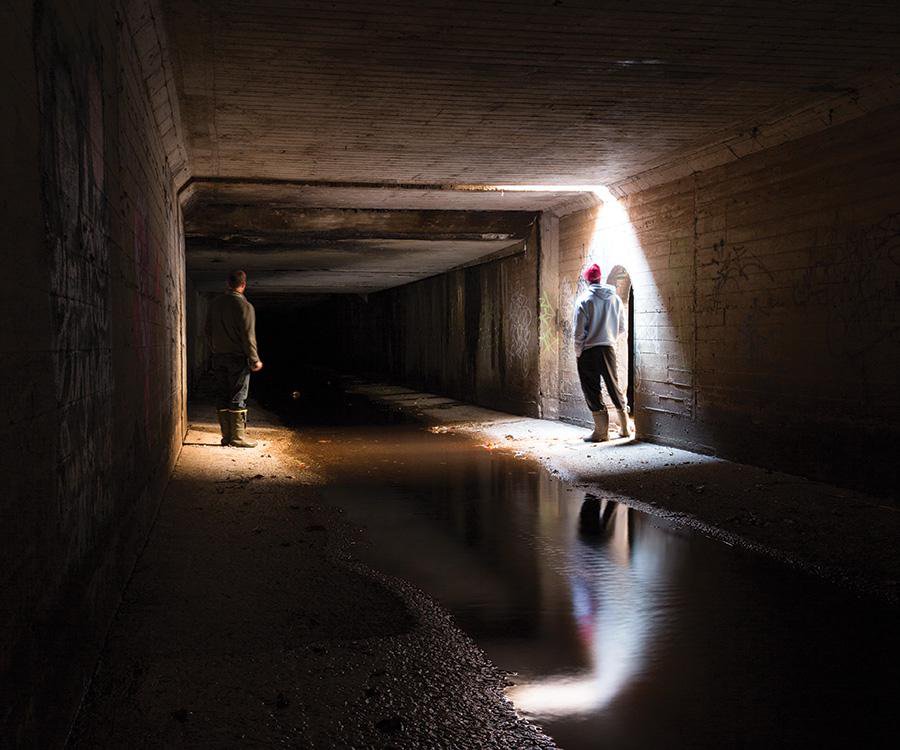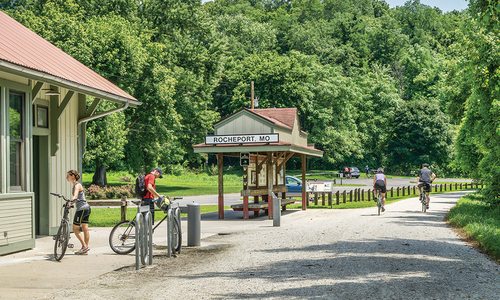Longform
The Rising Tide: Springfield's Stormwater Crisis
The battle to keep Springfield’s waterways clean rages once again, and this time there’s a hefty fine if we don’t comply. The problem? There’s currently no funding.
By Ettie Berneking | Photos by Chuck Travers
Jan 2016

The skies ahead threaten rain, but at the moment, Jordan Creek is little more than a trickle of water. Mike Kromrey, executive director of the Watershed Committee of the Ozarks, stands along the concrete bank. Up ahead is what’s known as the Jordan Creek “box”—a massive structure that entombs the creek for several miles. Kromrey leads tours of the box, and once inside, sunlight quickly disappears. A dim headlamp lights the way and catches glimpses of the graffiti scrawled across the box’s two concrete tunnels—each 11 feet wide and 10 feet tall.
Bats cling to the ceiling, and cigarette butts form sticky tar pits at the base of the walls. “These are the No. 1 pollutant found in stormwater runoff,” Kromrey says. “Flick a cigarette butt out of the car window, and it ends up here.” Every now and then Kromrey spots a minnow—a rarity in this water—but most often, it’s discarded clothing and bedding that floats downstream. There’s a sleeping bag back at the tunnel’s entrance. It’s snagged high up on a tree from when it was washed downstream after the last rainfall. Though they are dry right now, these tunnels can fill with rainwater in just a few seconds. That’s especially dangerous considering a lot of Springfield’s homeless take refuge in these tunnels at night.

After a heavy rain, the Jordan Creek can rise in mere seconds, bringing pollution with it.
But what worries Kromrey is the water quality. A quarter-mile into the tunnel and Kromrey spots a streak of white residue running down the middle of the creek bed. He pulls out his phone, snaps a photo, and makes a note to report the contaminant once he gets back to the office. “It’s most likely concrete that someone poured down the sewer,” he says. “That’s illegal.”

Both natural debris and concrete can block waterways and cause problems.
Kromrey isn’t the only one worried about contaminants getting into Springfield’s waterways. The city of Springfield has spent years and millions of dollars working to keep its rivers, streams, creeks and lakes up to federal standards set by the Environmental Protection Agency. But new unfunded mandates are set to take place in 2016, and if the city can’t clean up its water on its own, the EPA will step in, which could come with a price tag of more than $1.6 billion over 20 years.

The 1909 flood of Jordan Creek damaged property and flooded the area between Park Central Square and Chestnut Expressway .
A Decades-Long Struggle
The fight to protect Springfield’s waterways is nothing new. Just step inside the Jordan Creek Box. In many ways, this is where the discussion over water quality begins.
Back in the 1870s, Springfield had established itself as a center of commerce, and buildings were popping up around Jordan Creek. Natural forests were replaced by swaths of brick and concrete, which led to an increase in stormwater runoff. Water that used to soak into the ground and get filtered by plant roots now had nowhere to go except Jordan Creek. It wasn’t long before Springfield residents became familiar with the wrath of the angry waterway.

Jordan Creek flooded Boonville Avenue in 1909, causing citizens to seek higher ground.
According to the book Jordan Creek: Story of an Urban Stream by Loring Bullard, Jordan Creek flooded at least nine times between 1844 and 1909, which was one of the worst floods on record. By 1927, Springfield residents had tired of dealing with flood-damaged property and water-soaked homes, so voters passed a measure to box in Jordan Creek using concrete. One year later, in 1928, the “lid” over Jordan Creek between Main Street and Boonville Avenue was complete. But the tall concrete banks didn’t stop the flooding.
In 1932, the wrath of Jordan Creek was felt once again when record flooding took its toll on the city, which led to more of Jordan Creek being entombed in concrete. The result was the creation of the Jordan Creek Box and those graffitied tunnels that snake their way under city streets. At the time, it was said the Jordan had finally been tamed, but this was just the beginning of Springfield’s tumultuous relationship with its surrounding waterways.
The Root of the Problem
Back at his office inside the Watershed Center, Kromrey’s view is starkly different from that at Jordan Creek. Instead of being surrounded by paved parking lots and brick buildings, the Watershed is walled in by trees, rain gardens and Valley Water Mill Lake where anglers cast their lines for crappie, bass and catfish.
“When talking about water quality, you’re starting at the right place,” Kromrey says. The Watershed got its start in the early 1980s after two large algae blooms contaminated Springfield’s drinking water, which comes from the James River, Fellows Lake, McDaniel Lake and the Fullbright Spring. The water coming out of taps was gray in color and emitted a foul odor. The water was safe to drink, but the public was spooked—and for good reason. “Algae blooms form when nutrients like fertilizer and septic waste get into the waterways,” Kromrey explains. To address the foul water, Springfield created the Watershed Committee of the Ozarks in 1984 to serve as a public advocate for water quality. As executive director of the committee, Kromrey’s mission is to protect and sustain Springfield’s water supply through projects and education.
Scattered around the property are examples of projects Kromrey and the Watershed are working to install throughout Springfield. Rain gardens overflowing with native plants and flowers, are the easiest to spot thanks to the cuts in the concrete, which allow water to flow in and out of the garden. “These plants attract monarch butterflies, bees and all kinds of insects,” Kromrey says. “We don’t need fertilizer or pesticides because these plants are native and have adapted to our climate.” Another key advantage—their root systems.

Native plants like blackeyed susans are great for managing stormwater. Their root systems keep the soil locked down.
“Dirt is actually the No. 1 pollutant in America,” Kromrey says. “It’s weird to think about it, but if you’ve been floating on an Ozarks spring, you notice the water is crystal clear. That’s because the plant roots keep soil locked down. But if you cut the earth, it bleeds.” That means every time a new building goes up or land is developed, we lose that root system, and more dirt gets into waterways.
Grass isn’t terrible, but it doesn’t have the deep root system most native plants have. As Kromrey describes it, grass is a “drug-dependent rug with lollipop trees.” It needs a lot of fertilizer and maintenance and oftentimes water. In contrast, native plants have extensive root systems that burrow deep into the soil, helping them survive Missouri’s hot and often dry summers. They go a long way in the fight to prevent dirt erosion.
Wooded trails near the Watershed provide visitors with scenic hiking routes, and along one of these is a large grassy patch that looks like a regular ditch that’s been left alone so long plants and grasses have taken refuge in its shaded banks. But this isn’t a forgotten plot; it’s a tree-box filter. Should a heavy rain overwhelm the Watershed’s rain gardens and pervious concrete (which can absorb as much as five gallons of water in a matter of seconds), the stormwater can run off into these tree-box filters. Here, water is slowed down, spread out and soaked into the ground. It’s a simple solution, and it’s one the Watershed is sharing with the city.

The Watershed Committee of the Ozarks has projects that keep native plants in their natural habitat to help root down soil and reduce pollution.
Examples of Progress
Over the last two years, The Watershed Committee of the Ozarks has spent nearly $2 million completing community projects geared toward slowing down, spreading out and soaking in stormwater runoff. These projects were funded through the Big Urbie grant, which the city was awarded in 2013. In total, $1.1 million in federal funds were spent along with $770,000 in local matched dollars. By 2015, 9,250 native plants were put in the ground, seven river cleanups were hosted, 28,562 gallons of rainwater were harvested and 20 projects were completed.
On that list of projects: a rain garden with native plants at Messiah Lutheran Church; 1,700 gallons of rainwater harvested from the roof of Gilardi’s used to water the restaurant’s vegetable and herb gardens; the construction of a pervious paver patio at Homegrown Food; the installment of a 20,000-gallon rainwater collection system at Missouri State University’s William H. Darr School of Agriculture; a new detention basin and stormwater improvements at Drury University; the construction of pervious parking lots at Boyd Elementary and Robberson Elementary; and the reconstruction of the parking lot at City Government Plaza.
“Before this project, this was a desolate, bleak place,” says Carrie Lamb, a water quality coordinator with the city of Springfield. “The pavement was in bad shape; the layout was awkward; there was no plant life.” Standing in the parking lot at City Government Plaza, Kromrey and Lamb walk near the new bio swell that was completed last spring. This large cut in the ground is now home to fragrant prairie dropseed, witchhazel, blackeyed susans, purple poppy and pink irises. During heavy rains, stormwater can pool in this bio swell and be absorbed into the ground. Water that doesn’t make it here runs into the rain gardens lining one end of the lot before emptying out onto pervious pavers.
Projects like this can be costly, and it can often be difficult to convince the community of their benefits, but when Kromrey looks at the finished parking lot and its many water quality features, he doesn’t look at the bottom line. “There’s another way to measure cost,” he says. “This saves money with flood control, it uses native plants which cost less to maintain, and it has social impacts as well. When you look at the cost through that broader lens, you can look past the bare bones economic cost and see that this is worth it.”
But projects like this do cost money—money the city doesn’t have. For several years, stormwater improvement was funded through an ⅛-cent sales tax. But that tax sunset in 2012, which has left the city’s stormwater to-do list essentially unfunded. The city and county have identified a backlog of nearly $200 million in priority flood control needs and $500 million in infrastructure needs, so that to-do list is a long one. Now that the EPA is about to hand down new permits, which will require the city to up its stormwater control, the dash to find funding has begun.

The Kelley-Stokes Pedestrian Bridge completes the trail around the Valley Water Mill Reservoir and looks down on the Dam Spillway.
The Funding Dilemma
“This all goes back to 1972,” says Deputy City Manager, Tim Smith, “when the Clean Water Act passed and the EPA was formed.” As Smith describes, the EPA was aggressively going after visible sources of pollution, or point-sources as they’re referred to. When less-obvious pollutants were ignored, including stormwater, agriculture runoff and general air quality, environmental groups sued, and an amendment to the Clean Water Act mandated that the EPA regulate stormwater runoff. “The hard thing is stormwater runoff is non-point,” Smith explains. “You can’t go turn it off in one place.” When it rains, fertilizer, cigarette butts and even animal waste contaminate the water.
According to the latest numbers, a 1,000-square-foot roof can produce 600 gallons of stormwater runoff with just 1 inch of rain. That’s a lot of water, and it has to go somewhere. To regulate all these non-point source pollutants, the EPA hands out MS4 permits, which stand for municipal separate storm sewer system permits, and require cities to manage the quality of stormwater discharge into downstream waterways.
“We have to show that we reduce pollutants,” Smith says. “We have to show that we have an erosion and sediment control program and that we have a program to find illicit discharge (pollutant that can be toxic to wildlife in waterways)...” The list goes on. But with no secure funding mechanism, little effort can be made, but that won’t keep Springfield from having to pay steep fines if it doesn’t meet the new MS4 permit.
“Right now, we’re sweating this one out,” Smith says, and there’s no funding solution on the table. “This is the same question we are all grappling with. Will this be a new sales tax? Will it be a fee? And to complicate it even more, this issue is competing with other community needs like funding for the justice system and upgrading the jail.” Ask most Springfield residents which issue would concern them more, criminal safety or stormwater runoff, and it’s likely stormwater would take a back seat.

Mike Kromrey’s office at the Watershed Center lets him work right by the rain gardens he oversees.
The Solution
With funding running out and new EPA permits looming in the distance, the city formed a stormwater task force to look at possible funding options. Its suggestion: another sales tax. “They found that an ⅛-cent sales tax plus a ¹∕10-cent county sales tax would fund the $11.3 million need,” says Erin Kemper, assistant director for the Department of Environmental Services. While the proposed tax is still being discussed, at this point it’s just one option. No date has been set for voters to approve it, but Kemper and the task force do know what that tax could cover.
“That includes $2.8 million a year in Operations and Water Quality Mandates, $6 million a year in flooding costs, $2.5 million annually in infrastructure replacements, and that doesn’t even keep us up with the age curve,” Kemper says. Specifically, it’s the age curve, or point when stormwater pipes need to be replaced, that has Kemper on alert when he looks at the reach of the sales tax. The average lifespan of these pipes ranges from 50 to 100 years, but that $11.3 million would only allow the city to replace pipes every 200 years. That has Kemper concerned, which is why he has been presenting City Manager Greg Burris’s integrated plan that would address water quality, stormwater runoff, wastewater and even air quality all at the same time. “The concept is to not think about everything in its solo arena,” he explains. “We need to think about it in one big concept, which it is. When city utilities has an issue with its water quality, that’s due to poor water flowing in from the creek, and that water is contaminated because of polluted stormwater. It’s all connected.”
Since first proposing this integrated plan to the EPA in 2013, Kemper has presented the concept more than 25 times, including in front of the U.S. House of Representatives Subcommittee on Water Resources and Environment. According to the plan, “When combined, the potential water, air, and solid waste environmental mandates for Springfield, Greene County, and City Utilities could exceed $1.6 billion over the next 10 to 15 years.” That hefty price tag is why the plan suggests developing a pilot project that would address issues based on affordability, effectiveness, fairness and measurability, to name a few. The plan is new, and the first of its kind in the United States, but it’s getting attention. “We pitched this to the EPA, and they said, ‘Okay. Try it,’” Kemper says.
Kemper has begun looking at the laundry list of possible projects and will be prioritizing the biggest problems, the biggest costs, but also, the biggest benefits. One project that’s been brought up: removing Jordan Creek’s concrete tomb. But until funding is secured, whether through the proposed sales tax or other means, all progress has stopped, which is a concern for Kemper, who knows the cost that comes with ignoring the MS4 permit. But it’s also a concern for Kromrey, who sees the waterways as one of the city’s biggest assets. “Our streams and rivers are our heritage,” he says. “We have to convince the community to do this. We don’t have a choice.”












